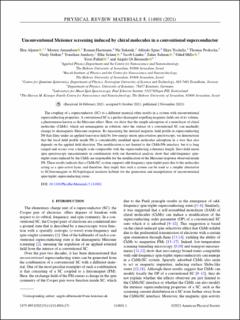| dc.contributor.author | Alpern, Hen | |
| dc.contributor.author | Amundsen, Morten | |
| dc.contributor.author | Hartmann, Roman | |
| dc.contributor.author | Sukenik, Nir | |
| dc.contributor.author | Spuri, Alfredo | |
| dc.contributor.author | Yochelis, Shira | |
| dc.contributor.author | Prokscha, Thomas | |
| dc.contributor.author | Gutkin, Vitaly | |
| dc.contributor.author | Anahory, Yonathan | |
| dc.contributor.author | Scheer, Elke | |
| dc.contributor.author | Linder, Jacob | |
| dc.contributor.author | Salman, Zaher | |
| dc.contributor.author | Millo, Oded | |
| dc.contributor.author | Paltiel, Yossi | |
| dc.contributor.author | Di Bernardo, Angelo | |
| dc.date.accessioned | 2022-03-04T10:14:13Z | |
| dc.date.available | 2022-03-04T10:14:13Z | |
| dc.date.created | 2021-12-02T10:56:22Z | |
| dc.date.issued | 2021 | |
| dc.identifier.issn | 2475-9953 | |
| dc.identifier.uri | https://hdl.handle.net/11250/2983070 | |
| dc.description.abstract | The coupling of a superconductor (SC) to a different material often results in a system with unconventional superconducting properties. A conventional SC is a perfect diamagnet expelling magnetic fields out of its volume, a phenomenon known as the Meissner effect. Here, we show that the simple adsorption of a monolayer of chiral molecules (ChMs), which are nonmagnetic in solution, onto the surface of a conventional SC can markedly change its diamagnetic Meissner response. By measuring the internal magnetic field profile in superconducting Nb thin films under an applied transverse field by low-energy muon spin rotation spectroscopy, we demonstrate that the local field profile inside Nb is considerably modified upon molecular adsorption in a way that also depends on the applied field direction. The modification is not limited to the ChMs/Nb interface, but it is long ranged and occurs over a length scale comparable with the superconducting coherence length. Zero-field muon spin spectroscopy measurements in combination with our theoretical analysis show that odd-frequency spin-triplet states induced by the ChMs are responsible for the modification of the Meissner response observed inside Nb. These results indicate that a ChMs/SC system supports odd-frequency spin-triplet pairs due to the molecules acting as a spin-active layer, and therefore, they imply that such a system can be used as a simpler alternative to SC/ferromagnet or SC/topological insulator hybrids for the generation and manipulation of unconventional spin-triplet superconducting states. | en_US |
| dc.language.iso | eng | en_US |
| dc.publisher | American Physical Society | en_US |
| dc.title | Unconventional Meissner screening induced by chiral molecules in a conventional superconductor | en_US |
| dc.type | Peer reviewed | en_US |
| dc.type | Journal article | en_US |
| dc.description.version | publishedVersion | en_US |
| dc.rights.holder | ©2021 American Physical Society | en_US |
| dc.source.volume | 5 | en_US |
| dc.source.journal | PHYSICAL REVIEW MATERIALS | en_US |
| dc.source.issue | 11 | en_US |
| dc.identifier.doi | 10.1103/PhysRevMaterials.5.114801 | |
| dc.identifier.cristin | 1963226 | |
| dc.relation.project | Norges forskningsråd: 262633 | en_US |
| cristin.ispublished | true | |
| cristin.fulltext | postprint | |
| cristin.qualitycode | 1 | |
